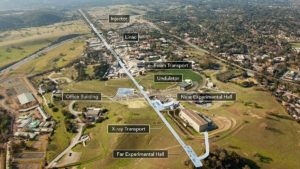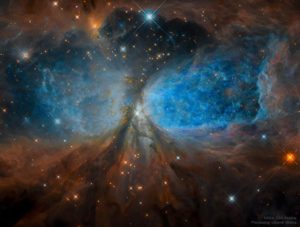 Stanford Linear Accelerator
Stanford Linear Accelerator
Physics faculty at UMW collaborate on cutting edge experiments at the Linear Coherence Light Source (LCSL), an X-ray laser fueled by the high energy linear accelerator at Stanford University (SLAC). Students have the opportunity to travel to SLAC and participate in these experiments with scientific leaders in the field of ultrafast physics – the physics of atoms and molecules focused on making movies of their fastest motions. An upcoming experiment, which involves two physics majors at UMW, planned for the 24th of October, has been delayed due the COVID-19 pandemic. Nonetheless, the students are participating in weekly meetings with scientists at SLAC planning the experiment and providing the necessary theoretical physics background for the experiment as part of their honors research work.
UMW Femtosecond Laser Lab
UM W has its own femtosecond laser lab on campus. The laser itself is now being assembled from scratch by students working with Prof. Varun Makhija. Once built, the laser will produce bursts of light that last for a millionth of a billionth of a second. During this short a time, molecules like H2O or O2 do not move. This light can therefore be used as a fast flash to take ‘freeze frame photographs’ of the molecule, which can then be strung together into a molecular movie.
W has its own femtosecond laser lab on campus. The laser itself is now being assembled from scratch by students working with Prof. Varun Makhija. Once built, the laser will produce bursts of light that last for a millionth of a billionth of a second. During this short a time, molecules like H2O or O2 do not move. This light can therefore be used as a fast flash to take ‘freeze frame photographs’ of the molecule, which can then be strung together into a molecular movie.
High Intensity Femtosecond Lasers
Prof. Makhija’s students also work in collaboration with scientists at the National Research Council Canada, where extremely bright and energetic sources of light are available, also producing bursts of light that last for a millionth of a billionth a second. These short flashes are also used to make movies of the fastest motions of atoms and molecules. Much like the collaboration with SLAC, our students work directly with leading scientists in the field, having regular remote meetings and discussions.
Particle Theory and Phenomenology
Prof. Villalba works on understanding how matter interacts and behaves at a fundamental scale. Many outstanding questions remain that our current Standard Model of particle physics doesn’t address. What is dark matter?, why do fermions have such a wide range of varying masses?, why is there more matter than anti-matter?, are just a few of these questions that he is interested in addressing. Students will have the opportunity to help tackle some of these fundamental questions and compare theoretical predictions to accelerator experiments and/or cosmological observations.
 Astrophysics
Astrophysics
Prof. Fleenor studies multi-wavelength astrophysics, he is excited to engage students with investigative projects that combine astronomical observation and theory. These projects often begin with optical observation (either photometry or spectroscopy) and maintain the potential to extend into non-optical wavelengths. In the recent past, student projects have focused on globular clusters (of stars), active galactic nuclei, and pulsars.
Physics Education and STEM Identity
Prof. Fleenor is also currently involved in two educational ventures that support and inform undergraduate participation in the physical sciences. He serves as an instructor and curriculum developer for national (multi-institutional), astronomy education grants. These grants provide introductory experiences that utilize cutting-edge astronomical techniques and tools that also utilize multi-wavelength observations. In one grant, our current area of focus is star-forming regions in the Milky Way Galaxy. In addition, he collaborates on a multi-year study to better understand undergraduate motivations (identity, belonging, and participation) to major in physics and continue in STEM. We are currently in Phase Two of the project, which seeks to learn about whether curricular and programmatic innovations influence more equitable student participation
Summer Science Institute
Students in the sciences at UMW have a unique opportunity to participate in a 10-week long, multi-departmental Summer Science Institute supported by the University, which provides full room and board for the duration. One or two faculty members from each of the STEM disciplines are selected for participation in the Institute each year. Those faculty invite outstanding students with a drive for research to work with them, conducting research for the full summer. At the conclusion of the program, students present their research in a day-long research symposium.